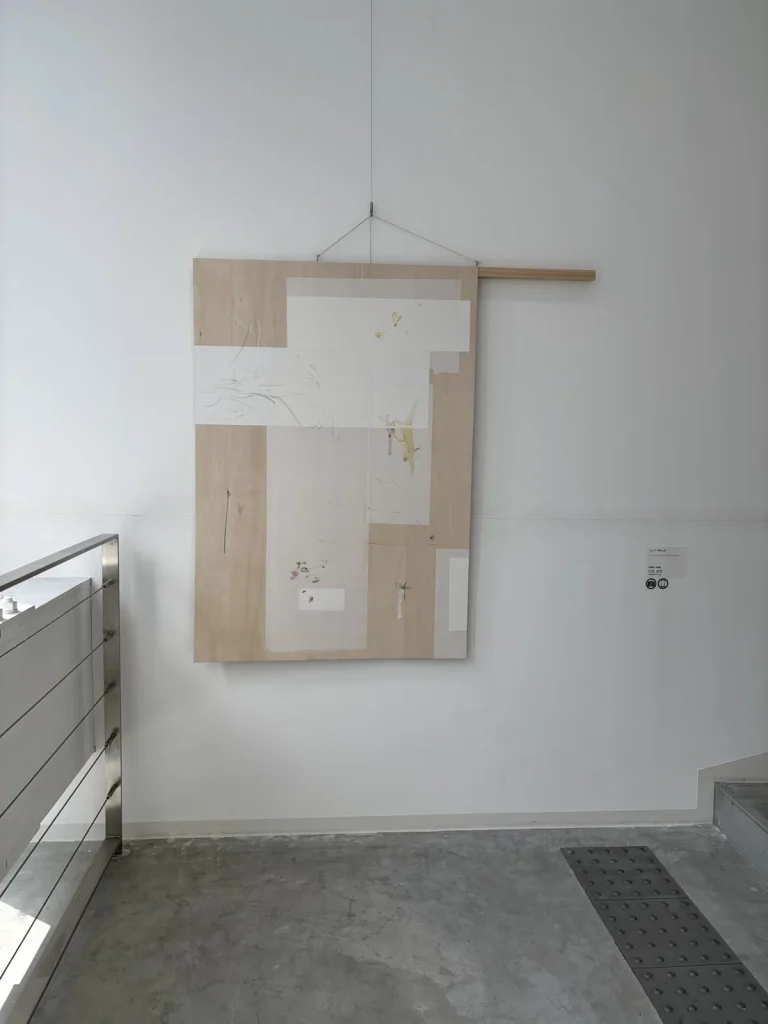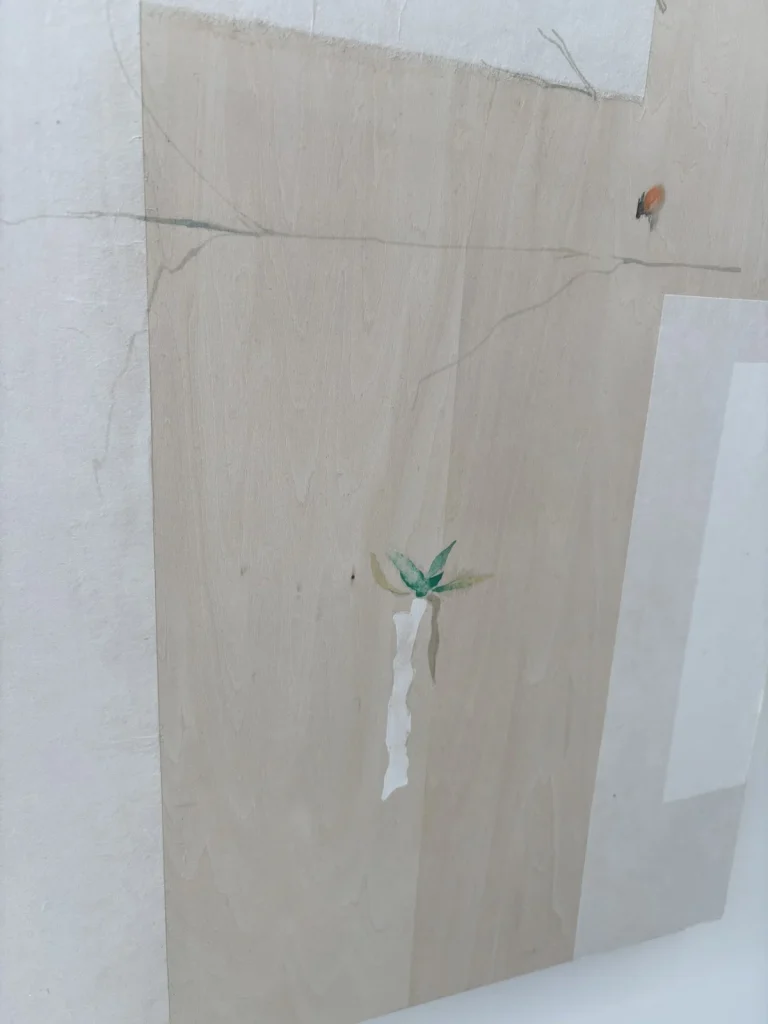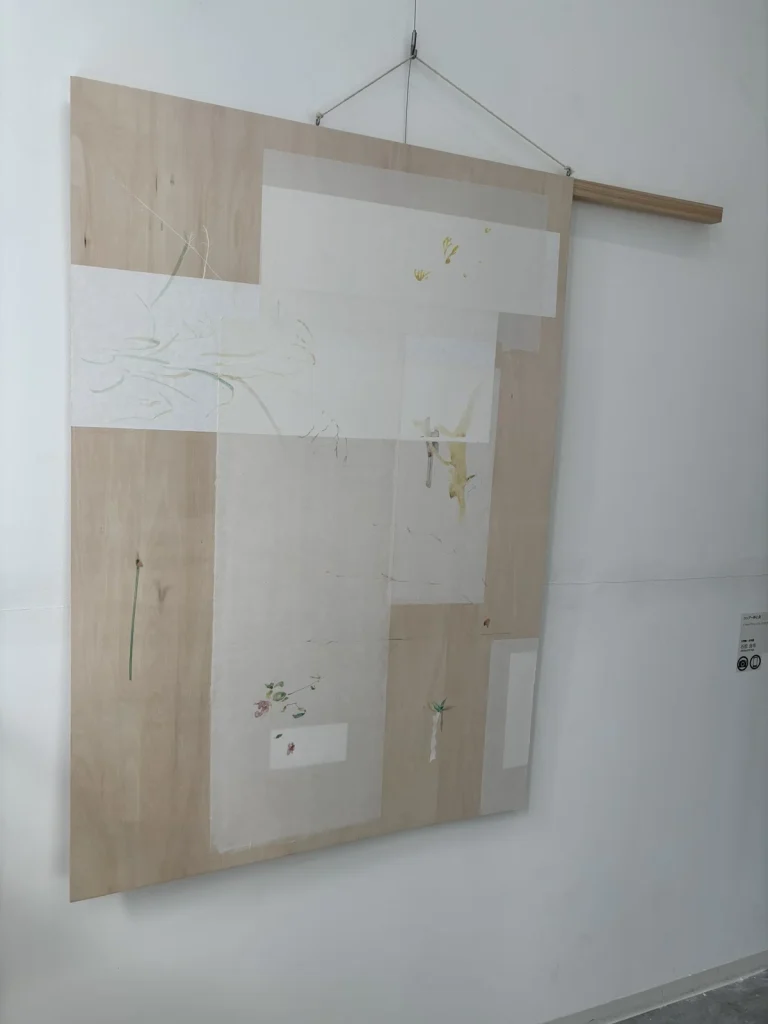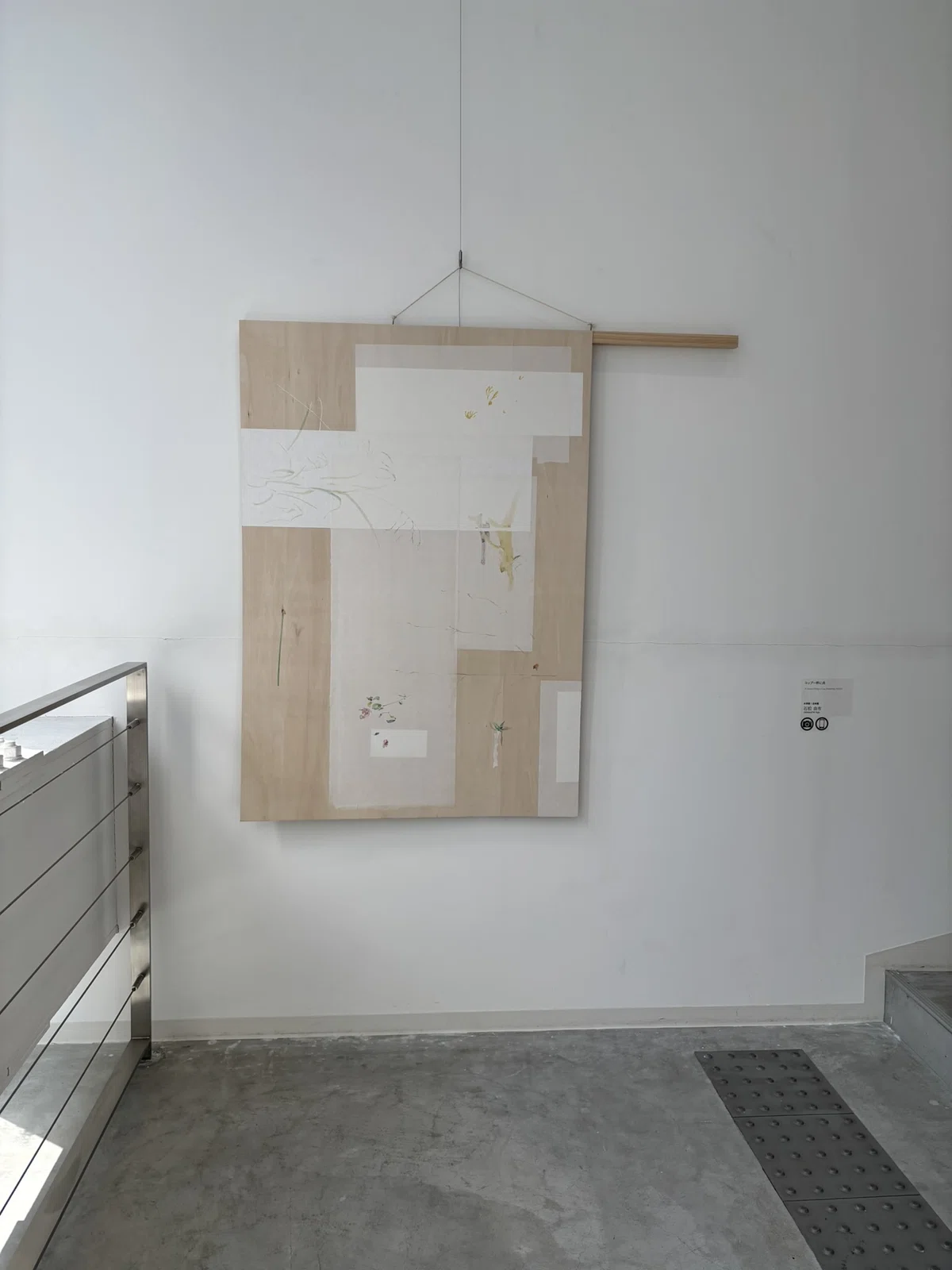A Review by Saito Tsutomu Originally published in Japanese on note.com
Exhibition: Saga University Graduation Exhibition
Year: 2025
Medium: Japanese paper on Shina plywood
Institution: Saga University
Opening Context
Ishimatsu Yufu’s work “A Vessel Filling a Cup, Breathing Within” was presented on the landing of the museum staircase at Saga University’s graduation exhibition. I viewed the work both in the morning and at noon. In the morning, it particularly glowed, illuminated by the sunlight.
The Work

Large Shina plywood serves as the support, with Japanese paper affixed to it. Plant and flower motifs are painted on both the base and the Japanese paper, seemingly playing freely on the surface and beneath it.

The Shina plywood used as the support has distortions, with the lower left portion curving forward. Wooden panels are usually fixed firmly to wooden frames to prevent warping, but this wooden frame is T-shaped, and the protruding wooden frame at the upper right seems to indicate a direction, as if continuing somewhere. The distortion in the lower left then appears to invite the viewer, which I interpret as the artist’s intention. Thus, a dialogue with the work begins.

The work presented on the staircase landing appears to sway like being rocked in a boat as one climbs the stairs step by step. The cup of water is perhaps for arranging the plant and flower subjects. The work placed within spatial continuity demonstrated a refined spatial beauty on the museum’s staircase landing.
Spatial Experience
The work presented on the staircase landing appears to sway like being rocked in a boat as one climbs the stairs step by step. The cup of water is perhaps for arranging the plant and flower subjects. The work, placed within spatial continuity, demonstrated a refined spatial beauty on the museum’s staircase landing.
What deserves attention here is the choice of the landing as the exhibition space. A landing is an intermediate space connecting upper and lower floors, a temporary point of pause in the midst of movement. This “intermediacy” resonates with the relationship between support and expression that the work presents. The delicate balance of neither concealing the Shina plywood support nor treating it as mere material mirrors the nature of the landing space.
This choice of exhibition space also resonates with the Japanese architectural concept of “transitional spaces.” In traditional Japanese architecture, spaces like corridors (rōka) and verandas (engawa) serve as important mediating zones between interior and exterior, movement and stillness. These transitional spaces are not merely functional passages but create meaningful pauses that prepare one for moving between different environments.
Ishimatsu’s practice draws upon this tradition while offering a contemporary reinterpretation. Viewers pause before the work while being guided into a dynamic experience through the transitional nature of the space, rather than static observation.
Materiality and Light
The appearance of the work glowing in morning light emphasized the materiality of the support. Through the shifting of light, the wood grain of the Shina plywood, the texture of the Japanese paper, and even the intentionally created distortions showed changing expressions over time. This suggests new possibilities different from the traditional approach to supports in Japanese painting.
In conventional Japanese painting, supports are typically concealed to direct attention to the painted imagery. Traditional formats like hanging scrolls (kakejiku), folding screens (byōbu), and sliding door paintings (fusuma-e) employ various mounting and framing techniques that render the support “transparent.” These formats were designed to integrate seamlessly within Japanese architectural spaces—hanging scrolls displayed in the tokonoma (alcove), screens positioned to divide rooms, and sliding doors that function as both architectural elements and painted surfaces.
However, Ishimatsu’s approach consciously questions this convention. In “A Vessel Filling a Cup, Breathing Within,” the wooden support is presented not as something to be hidden but as an active element of the work’s expression. The support functions in relationship with light and space, opening new possibilities for how materiality and expression can interact in Japanese painting.
This practice poses fundamental questions about traditional assumptions while still honoring the spatial sensibilities that have long characterized Japanese art’s relationship with architecture and environment.
Contemporary Reinterpretation
In conventional Japanese painting production, supports have generally been hidden behind the work as material foundations supporting the final expression. Various techniques—mounting in hanging scrolls, framing in screens and sliding doors, paper stretching on wooden panels—each serves to render the support “transparent,” directing viewers’ attention to the painted images and expressions. However, Ishimatsu’s practice can be read as a conscious questioning of this tacit understanding.
In “A Vessel Filling a Cup, Breathing Within,” the wooden board as support is presented not as something to be concealed but rather as an important formal element of the work. This goes beyond mere technical experimentation; it becomes an attempt to fundamentally question the relationship between support and expression in Japanese painting.
Each traditional format—hanging scrolls (kakejiku), standing screens (tsuitate), sliding door paintings (fusuma-e), and their relationships with Japanese architectural elements—possess unique spatiality and expressive possibilities, fundamentally tied to their integration within lived architectural spaces. These formats were never conceived as autonomous art objects but as integral components of spatial environments designed for daily life, ceremony, and contemplation.
Exhibition: Saga University Graduation Exhibition
Medium: Japanese paper on Shina plywood
Year: 2025
